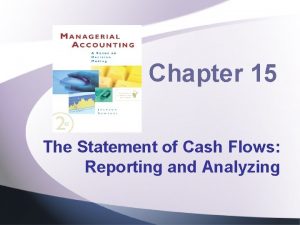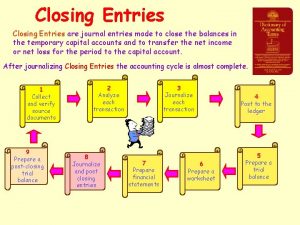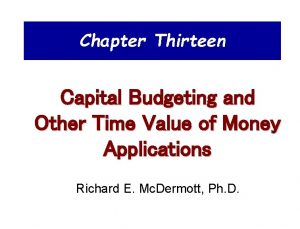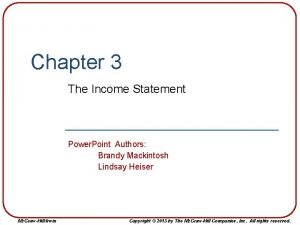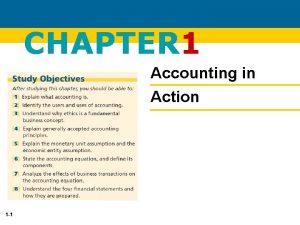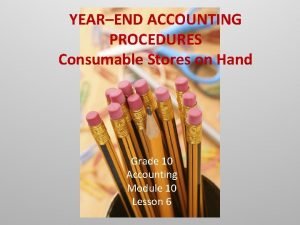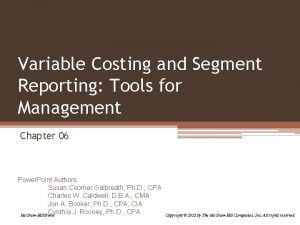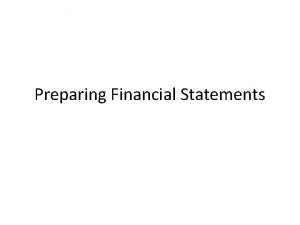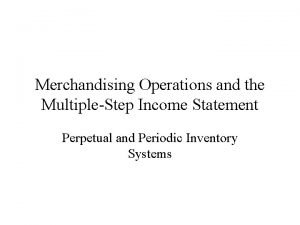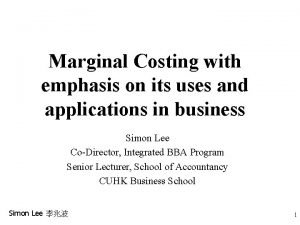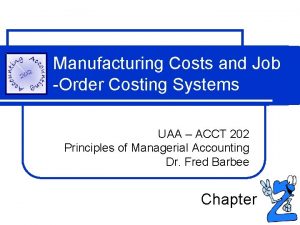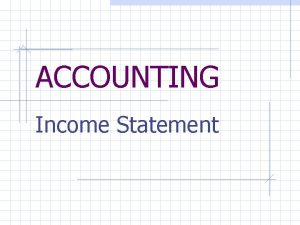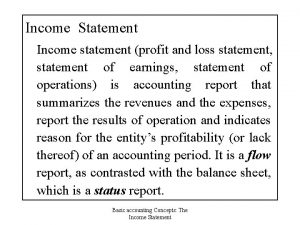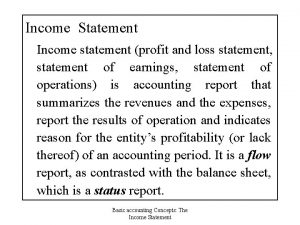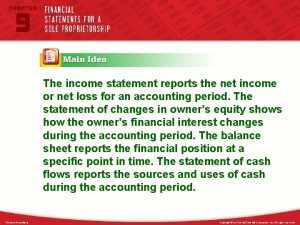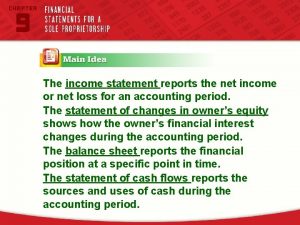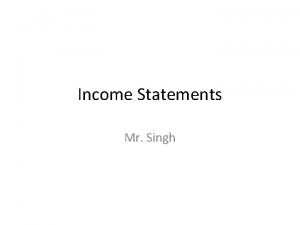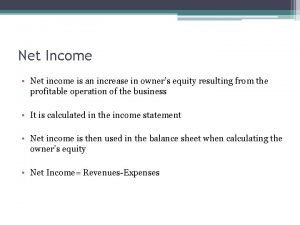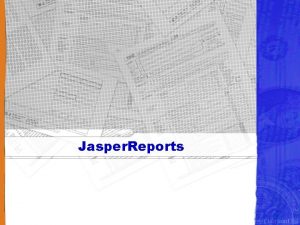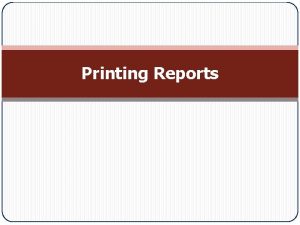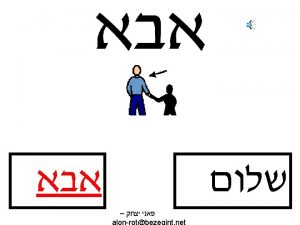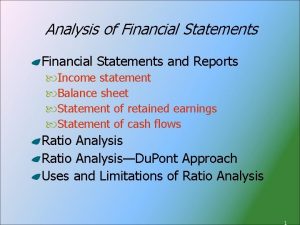Home The income statement reports the net income






































- Slides: 38

Home

The income statement reports the net income or net loss for an accounting period. The statement of changes in owner’s equity shows how the owner’s financial interest changes during the accounting period. The balance sheet reports the financial position at a specific point in time. The statement of cash flows reports the sources and uses of cash during the accounting period. Home Glencoe Accounting Copyright © by The Mc. Graw-Hill Companies, Inc. All rights reserved.

Explain the purpose of the income statement. Prepare an income statement. Explain the purpose of the statement of changes in owner’s equity. Prepare a statement of changes in owner’s equity. Explain the purpose of the balance sheet. Prepare a balance sheet. Explain the purpose of the statement of cash flows. Explain ratio analysis and compute ratios. Home Glencoe Accounting Copyright © by The Mc. Graw-Hill Companies, Inc. All rights reserved.

Section 9. 1 The Income Statement Key Terms financial statements income statements Home Glencoe Accounting Copyright © by The Mc. Graw-Hill Companies, Inc. All rights reserved.

Financial Statements Section 9. 1 The Income Statement Home Glencoe Accounting Copyright © by The Mc. Graw-Hill Companies, Inc. All rights reserved.

Financial Statements Section 9. 1 The Income Statement Four Types of Financial Statements Balance Sheet Statement of Changes in Owner’s Equity Statement of Cash Flows financial statements Reports prepared to summarize the changes resulting from business transactions that occur during an accounting period. Home Glencoe Accounting Copyright © by The Mc. Graw-Hill Companies, Inc. All rights reserved.

The Income Statement Section 9. 1 The Income Statement The Heading Sections of the Income Statement The Revenue for the Period The Expenses for the Period The Net Income or Net Loss for the Period income statement A report of the net income or net loss for a specific period; sometimes called a profit-and-loss statement or earnings statement. Home Glencoe Accounting Copyright © by The Mc. Graw-Hill Companies, Inc. All rights reserved.

The Income Statement Section 9. 1 The Income Statement Name of the business Name of the report The Heading Period covered Zip Delivery Service See page 224 Home Glencoe Accounting Copyright © by The Mc. Graw-Hill Companies, Inc. All rights reserved.

The Income Statement Section 9. 1 The Income Statement Revenue Section A Write Revenue. B Enter revenue account names. C Enter the balance of each revenue account. Home Glencoe Accounting See page 225 Copyright © by The Mc. Graw-Hill Companies, Inc. All rights reserved.

The Income Statement Section 9. 1 The Income Statement Expenses Section D Write Expenses. E Enter expense account names. F Draw a single rule line under the last balance. G Write Total Expenses. H Add the balances for the expense accounts. Home Glencoe Accounting Copyright © by The Mc. Graw-Hill Companies, Inc. All rights reserved.

The Income Statement Section 9. 1 The Income Statement Net Income Section I Draw a single rule line under the total expenses amount. J Subtract the total expenses from total revenue. K Write Net Income. L If net income matches the amount on the work sheet, draw a double rule beneath the net income amount. Home Glencoe Accounting Copyright © by The Mc. Graw-Hill Companies, Inc. All rights reserved.

The Income Statement Section 9. 1 The Income Statement Reporting a Net Loss Home Glencoe Accounting See page 226 Copyright © by The Mc. Graw-Hill Companies, Inc. All rights reserved.

Section 9. 2 The Statement of Changes in Owner’s Equity Key Term statement of changes in owner’s equity Home Glencoe Accounting Copyright © by The Mc. Graw-Hill Companies, Inc. All rights reserved.

The Statement of Changes in Owner’s Equity Section 9. 2 The Statement of Changes in Owner’s Equity The work sheet Information needed to prepare the statement of changes in owner’s equity The income statement The owner’s capital account in the general ledger statement of changes in owner’s equity A financial statement that summarizes changes in the owner’s capital account as a result of business transactions during the period. Home Glencoe Accounting Copyright © by The Mc. Graw-Hill Companies, Inc. All rights reserved.

Completing the Statement of Changes in Owner’s Equity Section 9. 2 The Statement of Changes in Owner’s Equity Steps for Completing the Statement of Changes in Owner’s Equity A Write Beginning Capital. D Enter the total investment. B Enter the balance of the capital account. E Enter the words Net Income. C Enter the increases to the capital account. Zip Delivery Service Home Glencoe Accounting See page 229 Copyright © by The Mc. Graw-Hill Companies, Inc. All rights reserved.

Completing the Statement of Changes in Owner’s Equity Section 9. 2 The Statement of Changes in Owner’s Equity Steps for Completing the Statement of Changes in Owner’s Equity F Write Total Increase in Capital. I G Write Subtotal. J H List the decreases to the capital account. Enter the withdrawals amount and draw a single rule under the withdrawals amount. Write Ending Capital on the next line followed by a comma and the last day of the period. Subtract the withdrawals amount from the subtotal. Zip Delivery Service Home Glencoe Accounting Copyright © by The Mc. Graw-Hill Companies, Inc. All rights reserved.

Completing the Statement of Changes in Owner’s Equity Section 9. 2 The Statement of Changes in Owner’s Equity There are two ways to determine the owner’s capital account balance: Look at the ledger. Subtract additional investments from the balance shown on the work sheet. For an ongoing business, the capital account balance on the work sheet may not be the balance at the beginning of the period. Home Glencoe Accounting Copyright © by The Mc. Graw-Hill Companies, Inc. All rights reserved.

Completing the Statement of Changes in Owner’s Equity Section 9. 2 The Statement of Changes in Owner’s Equity Showing a Net Loss Island Burgers See page 231 Home Glencoe Accounting Copyright © by The Mc. Graw-Hill Companies, Inc. All rights reserved.

Section 9. 3 The Balance Sheet and the Statement of Cash Flows Key Terms balance sheet current assets report form current liabilities statement of cash flows working capital ratio analysis liquidity ratio profitability ratio current ratio return on sales quick ratio Home Glencoe Accounting Copyright © by The Mc. Graw-Hill Companies, Inc. All rights reserved.

The Balance Sheet Section 9. 3 The Balance Sheet and the Statement of Cash Flows The Balance Sheet Summarizes: What a business owns What a business owes What a business is worth balance sheet A report of the balances in the permanent accounts on a specific date. Home Glencoe Accounting Copyright © by The Mc. Graw-Hill Companies, Inc. All rights reserved.

The Balance Sheet Section 9. 3 The Balance Sheet and the Statement of Cash Flows Sections of the Balance Sheet The Heading Assets Liabilities and Owner’s Equity WHO The name of the business WHAT The name of the financial statement WHEN The date of the balance sheet Home Glencoe Accounting Copyright © by The Mc. Graw-Hill Companies, Inc. All rights reserved.

The Balance Sheet Section 9. 3 The Balance Sheet and the Statement of Cash Flows A balance sheet can be recorded in report form A balance sheet format that lists classifications one under another. Home Glencoe Accounting Copyright © by The Mc. Graw-Hill Companies, Inc. All rights reserved.

The Balance Sheet Section 9. 3 The Balance Sheet and the Statement of Cash Flows Assets Section A Write Assets. B List each asset account and draw a single rule under the last account balance. C Write Total Assets and enter the total of individual asset balances. Home Glencoe Accounting See page 235 Copyright © by The Mc. Graw-Hill Companies, Inc. All rights reserved.

The Balance Sheet Section 9. 3 The Balance Sheet and the Statement of Cash Flows Liabilities and Owner’s Equity Sections D Write Liabilities. E List the liability account names and balances and draw a single rule beneath the last account balance. F Write Total Liabilities and enter the total of individual liability balances. G Write Owner’s Equity. H Write the name of the capital account and enter the ending balance of the capital account. Home Glencoe Accounting Copyright © by The Mc. Graw-Hill Companies, Inc. All rights reserved.

The Balance Sheet Section 9. 3 The Balance Sheet and the Statement of Cash Flows Proving the Equality of the Balance Sheet • Draw a single rule beneath the capital account balance and write Total Liabilities and Owner’s Equity on the next line. • Add the total liabilities amount and the ending capital balance and enter this value in the second amount column. • Draw a double rule under the total assets amount and under the total liabilities and owner’s equity amount if the two values are equal. Home Glencoe Accounting Copyright © by The Mc. Graw-Hill Companies, Inc. All rights reserved.

The Statement of Cash Flows Section 9. 3 The Balance Sheet and the Statement of Cash Flows The amount of cash the business took in Statement of Cash Flows The sources of cash The amount of cash the business paid out The uses of cash statement of cash flows A financial statement that summarizes the cash receipts and cash payments resulting from business activities during a period. Home Glencoe Accounting Copyright © by The Mc. Graw-Hill Companies, Inc. All rights reserved.

Ratio Analysis Section 9. 3 The Balance Sheet and the Statement of Cash Flows What is ratio analysis? ratio analysis The process of evaluating the relationship between various amounts in the financial statements. Home Glencoe Accounting Copyright © by The Mc. Graw-Hill Companies, Inc. All rights reserved.

Ratio Analysis Section 9. 3 The Balance Sheet and the Statement of Cash Flows What is a profitability ratio? profitability ratio A ratio used to evaluate the earnings performance of a business during the accounting period. Home Glencoe Accounting Copyright © by The Mc. Graw-Hill Companies, Inc. All rights reserved.

Ratio Analysis Section 9. 3 The Balance Sheet and the Statement of Cash Flows Calculating the return on sales $1, 150 net income = 0. 434 or 43. 4% $2, 650 return on sales A ratio that examines the portion of each sales dollar that represents profit; calculated by dividing net income by sales. Home Glencoe Accounting Copyright © by The Mc. Graw-Hill Companies, Inc. All rights reserved.

Ratio Analysis Section 9. 3 The Balance Sheet and the Statement of Cash Flows Examples of Current Assets Account Receivable Cash in Bank current assets Assets that are used up or converted to cash during the normal operating cycle of the business. Supplies Home Glencoe Accounting Copyright © by The Mc. Graw-Hill Companies, Inc. All rights reserved.

Ratio Analysis Section 9. 3 The Balance Sheet and the Statement of Cash Flows Accounts payable is an example of a current liability Debts of the business that must be paid within the next accounting period. Home Glencoe Accounting Copyright © by The Mc. Graw-Hill Companies, Inc. All rights reserved.

Ratio Analysis Section 9. 3 The Balance Sheet and the Statement of Cash Flows Current assets - current liability = working capital The amount by which current assets exceed current liabilities. Home Glencoe Accounting Copyright © by The Mc. Graw-Hill Companies, Inc. All rights reserved.

Ratio Analysis Section 9. 3 The Balance Sheet and the Statement of Cash Flows What is a liquidity ratio? liquidity ratio A measure of the ability of a business to pay its current debts as they become due and to provide for an unexpected need for cash. Home Glencoe Accounting Copyright © by The Mc. Graw-Hill Companies, Inc. All rights reserved.

Ratio Analysis Section 9. 3 The Balance Sheet and the Statement of Cash Flows What is the current ratio? current ratio The relationship between current assets and current liabilities; calculated by dividing current assets by current liabilities. Home Glencoe Accounting Copyright © by The Mc. Graw-Hill Companies, Inc. All rights reserved.

Ratio Analysis Section 9. 3 The Balance Sheet and the Statement of Cash Flows What is the quick ratio? quick ratio A measure of the relationship between short-term assets and current liabilities; calculated by dividing the total cash and receivables by the current liabilities. Home Glencoe Accounting Copyright © by The Mc. Graw-Hill Companies, Inc. All rights reserved.

Question 1 Indicate with an I for income statement, a B for balance sheet, and an S for statement of changes in owner’s equity in which financial statement(s) you would most likely find the following. I, S I B Home Glencoe Accounting Copyright © by The Mc. Graw-Hill Companies, Inc. All rights reserved.

Question 2 How would you use the profitability and liquidity ratios to determine whether the business is moving in a positive direction? A ratio is most useful when it is compared to the same ratio prepared at several different times for the same company or compared to the same ratio prepared for the industry of which the business is part. Comparing to the industry average will let the owner or manager know how the business is performing in comparison to its competition. Home Glencoe Accounting Copyright © by The Mc. Graw-Hill Companies, Inc. All rights reserved.

End of Home
 Is a report formal or informal
Is a report formal or informal Operating income meaning
Operating income meaning The statement of cash flows reports
The statement of cash flows reports National income formula
National income formula Carrying value formula
Carrying value formula Chapter 16 accounting for income taxes
Chapter 16 accounting for income taxes Apa arti homecare
Apa arti homecare Perbedaan home care dan home visit
Perbedaan home care dan home visit New mobile home sales oak springs mobile home community
New mobile home sales oak springs mobile home community Flower plural
Flower plural Come home come home jesus is calling
Come home come home jesus is calling New mobile home sales oak springs mobile home community
New mobile home sales oak springs mobile home community Go to my house
Go to my house André fougeron
André fougeron She said that, home economics stands for the ideal home.
She said that, home economics stands for the ideal home. Home sweet home survive
Home sweet home survive When closing entries are made
When closing entries are made Payback period formula
Payback period formula Net income formula
Net income formula Margin of safety percentage formula
Margin of safety percentage formula Net income approach diagram
Net income approach diagram Determine junktrader’s preliminary net income.
Determine junktrader’s preliminary net income. Alpha star's net income is $300 on $2 000 of sales
Alpha star's net income is $300 on $2 000 of sales Chapter 2 test a accounting answer key
Chapter 2 test a accounting answer key Net income will result during a time period when
Net income will result during a time period when Wifi nethome
Wifi nethome Home.hiwaay.net/ krcool/astro/moon/moon tides/
Home.hiwaay.net/ krcool/astro/moon/moon tides/ How many days for a moon cycle
How many days for a moon cycle What is consumable stores in accounting
What is consumable stores in accounting Meaning of marginal costing
Meaning of marginal costing Variable costing and segment reporting tools for management
Variable costing and segment reporting tools for management Cash account title
Cash account title Revenue minus expenses equals
Revenue minus expenses equals Petty cash in income statement
Petty cash in income statement Papa geos
Papa geos Another name for income statement
Another name for income statement Multi step income statement perpetual inventory system
Multi step income statement perpetual inventory system Marginal cost income statement
Marginal cost income statement Dm + dl + moh
Dm + dl + moh


